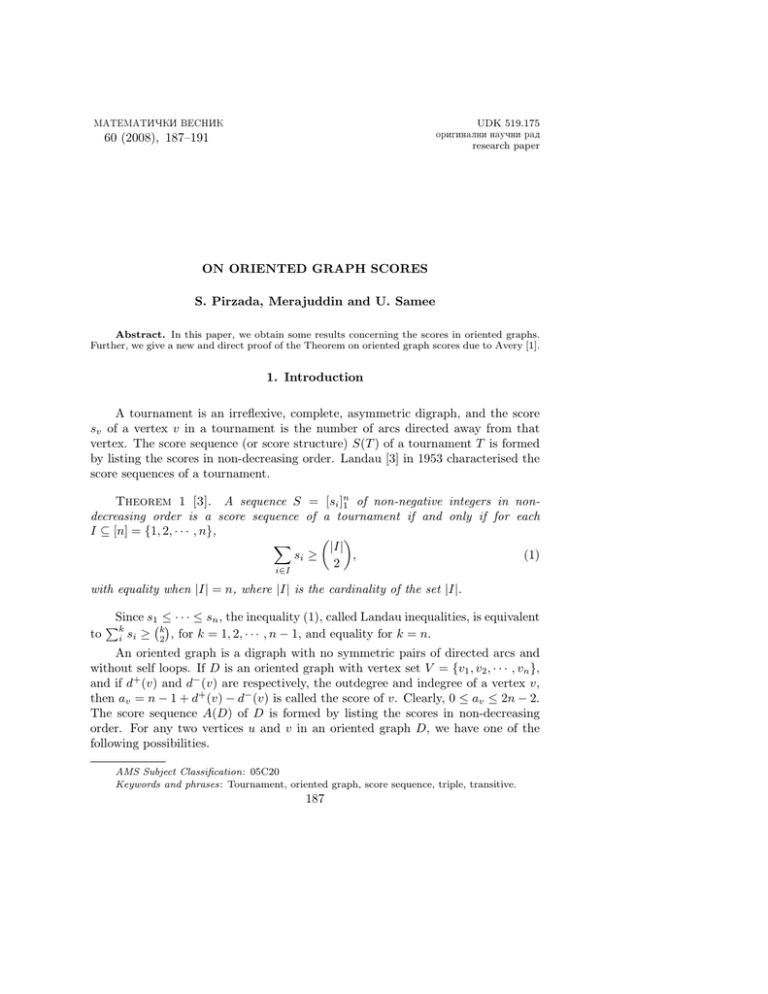60 (2008), 187–191 ON ORIENTED GRAPH SCORES
advertisement

MATEMATIQKI VESNIK
UDK 519.175
originalni nauqni rad
research paper
60 (2008), 187–191
ON ORIENTED GRAPH SCORES
S. Pirzada, Merajuddin and U. Samee
Abstract. In this paper, we obtain some results concerning the scores in oriented graphs.
Further, we give a new and direct proof of the Theorem on oriented graph scores due to Avery [1].
1. Introduction
A tournament is an irreflexive, complete, asymmetric digraph, and the score
sv of a vertex v in a tournament is the number of arcs directed away from that
vertex. The score sequence (or score structure) S(T ) of a tournament T is formed
by listing the scores in non-decreasing order. Landau [3] in 1953 characterised the
score sequences of a tournament.
Theorem 1 [3]. A sequence S = [si ]n1 of non-negative integers in nondecreasing order is a score sequence of a tournament if and only if for each
I ⊆ [n] = {1, 2, · · · , n},
µ ¶
X
|I|
si ≥
,
(1)
2
i∈I
with equality when |I| = n, where |I| is the cardinality of the set |I|.
Since s1 ≤ · · · ≤ sn , the inequality (1), called Landau inequalities, is equivalent
¡ ¢
Pk
to i si ≥ k2 , for k = 1, 2, · · · , n − 1, and equality for k = n.
An oriented graph is a digraph with no symmetric pairs of directed arcs and
without self loops. If D is an oriented graph with vertex set V = {v1 , v2 , · · · , vn },
and if d+ (v) and d− (v) are respectively, the outdegree and indegree of a vertex v,
then av = n − 1 + d+ (v) − d− (v) is called the score of v. Clearly, 0 ≤ av ≤ 2n − 2.
The score sequence A(D) of D is formed by listing the scores in non-decreasing
order. For any two vertices u and v in an oriented graph D, we have one of the
following possibilities.
AMS Subject Classification: 05C20
Keywords and phrases: Tournament, oriented graph, score sequence, triple, transitive.
187
188
S. Pirzada, Merajuddin and U. Samee
(i) An arc directed from u to v, denoted by u(1 − 0)v, (ii) An arc directed from
v to u, denoted by u(0 − 1)v, (iii) There is no arc from u to v and there is no arc
from v to u, and is denoted by u(0 − 0)v.
If d∗ (v) is the number of those vertices u in D which have v(0 − 0)u, then
d+ (v) + d− (v) + d∗ (v) = n − 1. Therefore, av = 2d+ (v) + d∗ (v). This implies that
each vertex u with v(1 − 0)u contributes two to the score¡ of¢ v. Since the number
of arcs and non-arcs in an oriented graph of order n is n2 , and each v(0 − 0)u
contributes two(one each at u and v) to scores, therefore the sum total of all the
n
scores is 2( 2 ) . With this scoring system, player v receives a total of av points.
A triple in an oriented graph is an induced oriented subgraph with three vertices. For any three vertices u, v and w, the triples of the form u(1 − 0)v(1 −
0)w(1 − 0)u, or u(1 − 0)v(1 − 0)w(0 − 0)u are said to be intransitive, while as the
triples of the form u(1 − 0)v(1 − 0)w(0 − 1)u, or u(1 − 0)v(0 − 1)w(0 − 0)u, or
u(1 − 0)v(0 − 0)w(0 − 1)u, or u(1 − 0)v(0 − 0)w(0 − 0)u, or u(0 − 0)v(0 − 0)w(0 − 0)u
are said to be transitive.
Theorem 2 [1]. A sequence A = [ai ]n1 of non-negative integers in nondecreasing order is a score sequence of an oriented graph if and only if for each
I ⊆ [n] = {1, 2, · · · , n},
µ ¶
X
|I|
ai ≥ 2
,
(2)
2
i∈I
with equality when |I| = n.
Since a1 ≤ a2 ≤ · · · ≤ an , the inequality (2) is equivalent to
k
X
i
µ ¶
k
,
2
ai ≥ 2
for
k = 1, 2, · · · , n − 1
(3)
with equality for k = n.
2. Main results
We give a constructive proof of the sufficiency of Theorem 2, based on the
proof of Griggs and Reid [2] for Theorem 1 on tournaments. This proof is more
direct in comparison to the previous existing ones. First we have the following
results.
Theorem 3. Let A = [ai ]n1
a2 ≤ · · · < ak = ak+1= · · · =
ai − 1,
0
0 n
0
A = [ai ]1 where ai = ai + 1,
ai ,
be a sequence of non-negative integers with a1 ≤
ak+m−1 < ak+m ≤ ak+m+1 ≤ · · · ≤ an and let
for i = k
for i = k + m − 1
otherwise.
Then A is a score sequence of some oriented graph if and only if A0 is a score
sequence of an oriented graph.
On oriented graph scores
189
Proof. Clearly, k ≥ 1 and m ≥ 2, so that either k + m − 1 = n, or
ak =ak+1 = · · · = ak+m−1 < ak+m . For 1 ≤ i ≤ n A0 = [a0i ]n1 where
ai − 1, for i = k
a0i = ai + 1, for i = k + m − 1
Obviously, a01 ≤ a02 ≤ · · · ≤ a0n .
ai ,
otherwise.
Let A0 be the score sequence of some oriented graph D0 of order n in which
0
vertex vi0 has score a0i , 1 ≤ i ≤ n. Then a0k+m−1 = a0k +2. If either vk+m−1
(1−0)vk0 ,
0
0
0
or vk+m−1 (0 − 0)vk then making respectively, the transformation vk+m−1 (0 − 0)vk0 ,
0
or vk0 (1 − 0)vk+m−1
, gives an oriented graph of order n with score sequence A.
0
If vk0 (1 − 0)vk+m−1
, since a0k ≤ a0k+m−1 there exists at least one vertex vj0 in
0
0
0
V − {vk , vk+m−1 } such that triple formed by vk0 , vk+m−1
and vj0 is transitive and
0
0
of the form vk0 (1 − 0)vk+m−1
(1 − 0)vj0 (1 − 0)vk0 or vk0 (1 − 0)vk+m−1
(1 − 0)vj0 (0 − 0)vk0
0
0
0
0
or vk (1 − 0)vk+m−1 (0 − 0)vj (1 − 0)vk . These can be transformed respectively to
0
0
vk0 (1 − 0)vk+m−1
(0 − 0)vj0 (0 − 0)vk0 or vk0 (1 − 0)vk+m−1
(1 − 0)vj0 (0 − 1)vk0 or vk0 (1 −
0
0
0
0)vk+m−1 (0 − 1)vj (0 − 0)vk , and we obtain an oriented graph of order n with score
sequence A.
0
0
0
If for every vertex V 0 − {vk0 , vk+m−1
} the triple formed by vk0 , vk+m−1
and vj0
is transitive, we again get a contradiction.
Now, let A be the score sequence of some oriented graph D of order n in which
vertex vi has score ai , 1 ≤ i ≤ n. We have ak+m−1 = ak . If either vk (1 − 0)vk+m−1 ,
or vk (0 − 0)vk+m−1 , then making respectively, the transformation vk (0 − 0)vk+m+1 ,
or vk (0 − 1)vk+m+1 , gives an oriented graph of order n with score sequence A0 . If
vk+m+1 (1−0)vk , we claim that there exists at least one vertex vj ∈ V −{vk+m+1 , vk }
such that the triple formed by the vertices vk+m+1 , vk and vj is intransitive, and of
the form vk+m+1 (1 − 0)vk (1 − 0)vj (1 − 0)vk+m+1 , or vk+m+1 (1 − 0)vk (1 − 0)vj (0 −
0)vk+m+1 , or vk+m+1 (1 − 0)vk (0 − 0)vj (1 − 0)vk+m+1 . These can be transformed
respectively to vk+m+1 (1 − 0)vk (0 − 0)vj (0 − 0)vk+m+1 , or vk+m+1 (1 − 0)vk (0 −
0)vj (0 − 1)vk+m+1 , or vk+m+1 (1 − 0)vk (0 − 1)vj (0 − 0)vk+m+1 and we obtain an
oriented graph of order n with score sequence A0 .
In case for every vertex vj ∈ V − {vk , vk+m−1 } the triple formed by vk+m−1 , vk
and vj is transitive, we again get a contradiction.
Thus, A0 is a score sequence if and only if A is a score sequence.
Theorem 4. Let A = [ai ]n1 be a sequence of non-negative integers in nondecreasing order withat least two odd terms ak and am (say) with ak < am and let
ai − 1, for i = k
0
0 n
0
A = [ai ]1 with ai =
ai + 1, for i = k + m − 1
ai ,
otherwise.
Then A is a score sequence if and only if A0 is a score sequence.
Proof. Let ak be the lowest odd term, and a be the greatest odd term and let
190
S. Pirzada, Merajuddin and U. Samee
ai − 1, for i = k
0
0
0
0
0
A = [a1 , a2 , · · · , an ], where ai =
ai + 1, for i = k + m − 1
ai ,
otherwise.
Clearly, a01 ≤ a02 ≤ · · · ≤ a0n .
Let A0 be the score sequence of some oriented graph D0 of order n in which
vertex vi0 has score a0i , 1 ≤ i ≤ n. Then, a0m ≥ a0k + 2 with equality appearing
when the two odd terms are same. Therefore, it follows by the argument used in
Theorem 3, that A is the score sequence of some oriented graph D of order n in
which vertex vi has score ai , 1 ≤ i ≤ n. We have am ≥ ak . The equality appears
when the two odd terms are same, and in this case A0 is a score sequence of some
oriented graph of order n, again by Theorem 3. If am > ak , then am ≥ ak + 2, since
am = ak + 1 implies that one of ak or am is even, which contradicts the choice of
ak and am . Thus, by using again the argument as in Theorem 3, it follows that A0
is a score sequence of some oriented graph of order n.
Lemma 5. (a) Let A and A0 be given as in Theorem 3. Then A satisfies (3)
if and only if A0 satisfies (3).
(b) Let A and A0 be given as in Theorem 4. Then A satisfies (3) if and only
0
if A satisfies (3).
Pk−1
Pj
Pj
Proof. (a) If A satisfies (3), then i=1 a0i = i=1 ai , or i=1 ai + (ak − 1) +
Pj
Pk+m−2
Pk
Pj
i=k+m ai according
i=k+1 +(ak+m−1 + 1) +
i=1 ai + (ak − 1) +
i=k+1 ai , or
to j ≤ k − 1, or k ≤ j ≤ k + m − 2, or j ≥ k + m − 1 respectively.
Pj
If j ≤ k − 1 and j ≥ k + m − 1, then i=1 a0i ≥ j(j − 1). If k ≤ j ≤ k + m − 2,
Pj
claim i=1 ai > j(j − 1), for k ≤ j ≤ k + m − 2.
Pj
Assume to the contrary, that for some j, k ≤ j < k +m−2, i=1 ai ≤ j(j −1).
Pj
Pj
For (3), we have i=1 ai ≥ j(j −1). Combining the two, we obtain i=1 ai = j(j −
Pj+1
Pj
1). Therefore, again by (3), we have aj+1 + j(j − 1) = aj+1 + i=1 ai = i=1 ai ≥
j(j+1) = j(j−1+2) = j(j−1)+2j. That is, aj+1 ≥ 2j. Also, aj = aj+1 implies that
Pj−1
Pj
aj ≥ 2j. Thus, i=1 ai = i=1 ai +aj ≥ (j −1)(j −2)+2j = j(j −1)−(j −1)+2j.
Pj
Therefore i=1 ai ≥ j(j − 1) + 2 > j(j − 1), contradicting the assumption. Hence,
j
X
ai > j(j − 1), for k ≤ j ≤ k + m − 2.
(4)
i=1
Pj
Pj
Thus, when k ≤ j ≤ k+m−2, using (4), we obtain i=1 a0i = i=1 ai −1 > j(j−1).
Therefore in all cases A0 satisfies (3). Now, if A0 satisfies (3), it can be easily
seen that A also satifies (3). Proof of (b) follows similarly.
Proof of Theorem 2. Necessity. It can be seen in [4].
Sufficiency. Let the sequence A = [ai ]n1 of non-negative integers n nondecreasing order satisfy (3). Clearly, the sequence A = [0, 2, 4, · · · , 2n − 2] satisfies
(3), since it is the score sequence of the transitive tournament of order n. Now, if
On oriented graph scores
191
any sequence A 6= An satisfies (3), then a1 ≥ 0 and an ≤ 2n − 2. We claim that A
contains either (a) a repeated term, or (b) at least two odd terms, or both (a) and
(b). To verify the claim, suppose that there is no repeated term. If at least one
term is odd, then a parity argument shows that there are at least two odd terms.
So assume that all terms are even. Therefore, a1 ≥ 0, a2 > a1 , and a2 even imply
that a2 ≥ 2. And a2 ≥ 2 a3 > a2 , and a3 even imply that a3 ≥ 4. Inductively,
Pn
Pj
ai ≥ 2(i−1), for all 1 ≤ i ≤ n. Thus, n(n−1) = i=1 ai ≥ 2 i=1 (i−1) = n(n−1).
This implies that equality holds throughout. Thus, ai = 2(i − 1), for all 1 ≤ i ≤ n,
and A = An , a contradiction. Consequently, if there is no repeated term, then at
least two terms are odd.
We produce a new sequence A0 from A which also satisfies (3), A0 is closer to
An than A, and A0 is a score sequence if and only if A is a score sequence. When
A contains a repeated term, reduce the first occurrence of that of that repeated
term in A by one and increase the last occurrence of that repeated term by one to
form A0 . If A contains at least two odd terms, reduce the first odd term by one
and increase the last odd term by one to form A0 . The process is repeated until the
sequence An is obtained. Let the total order on the non-negative integer sequences
be defined by X = [x1 , x2 , · · · , xn ] ¹ Y = [y1 , y2 , · · · , yn ] if either X = Y , or
xi < yi for some i, 1 ≤ i ≤ n, and xi+1 = yi+1 , · · · , xn = yn . Clearly, ¹ is reflexive,
antisymmetric and satisfies comparability. We write X ≺ Y , if X ≺ Y but X 6= Y .
For any sequence A 6= An , satisfies (3), A ≺ An , where An = [0, 2, 4, · · · , 2n − 2],
the score sequence of a transitive tournament of order n. Thus, we have shown
that for any sequence A0 satisfies (3), we can form another sequence A0 satisfying
(3)(By Lemma 5) such that A ≺ A0 , and A is a score sequence if and only if A0
is a score sequence (By Theorem 3 and 4). Therefore, by the repeated application
of this transformation, starting from the original sequence satisfying (3), we reach
An . Hence, A is a score sequence.
REFERENCES
[1] P. Avery, Score sequences of oriented graphs, J. Graph Theory, 15) (1991), 251–257.
[2] J. R. Griggs and K. B. Reid, Landau Theorem revisited, Australasian J. Combinatorics, 20
(1999), 19–24.
[3] H. G. Landau, On dominance relations and the structure of animal societies, 111. The condition for a score structure, Bull. Math. Biophys. 15 (1953), 143–148.
[4] S. Pirzada, T. A. Naikoo, and N. A. Shah, Score sequences in oriented graphs, J. Applied
Mathematics and Computing, 22(1) (2007), 257–268.
(received 07.08.2007, in revised form 18.12.2007)
S. Pirzada, Department of Mathematics, University of Kashmir, Srinagar, India.
E-mail: sdpirzada@yahoo.co.in
Merajuddin, Department of Applied Mathematics, Faculty of Engg. and Tech., A. M. U. Aligarh,
India.
E-mail: meraj1957@rediffmail.com
U. Samee, Department of Applied Mathematics, Faculty of Engg. and Tech., A. M. U. Aligarh,
India.
E-mail: pzsamee@yahoo.co.in







